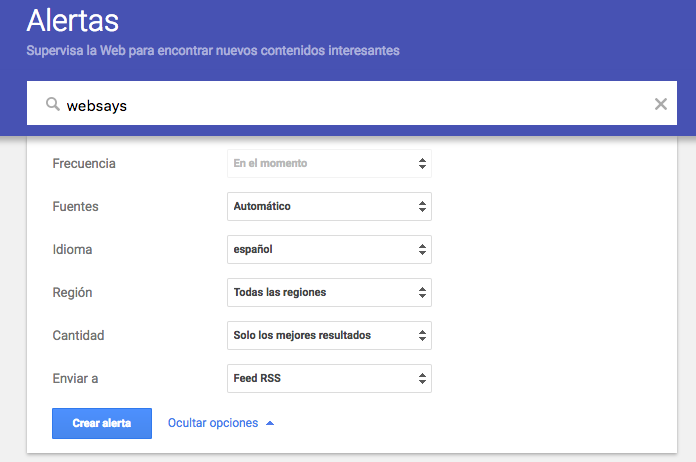More and more companies are deciding to monitor social media networks to search for mentions of their brand, their competitors or their market sector.
The data help to make better decisions, certainly, and the volume of data published daily on social media gives companies an additional tool practically for free. Knowing what consumers think helps companies better position their own product, make better decisions, and above all manage the brand’s reputation.
Below we present the best known and easiest to use among the free social network monitoring tools.
Google Alerts
Google alerts is a free Google tool that delivers mentions of selected words by e-mail. The Google alerts can be configured by language, region and frequency, among other filters, and there is no limit to the number of queries.
To establish tracking with Google Alerts, simply visit google.com/alerts and open a session with a gmail account.
Once the session is opened, we can begin to create alerts for the different terms we are interested in monitoring. The frequency of alerts will determine if we receive them daily, weekly, or at the moment the mention is published. These mentions are sent by e-mail as links with a preview of the text.
Google Alerts does not receive information from social media and only gathers news published on some digital media and blogs. It should be noted that Google Alerts does not track information from “small” or from recently created blogs, making it highly likely that some information will be lost.
Hootsuite
Hootsuite, in addition to helping to manage social networks, allows the creation of columns that group together tweets posted on different queries. In this case, for each word or group of words that we want to track, we would have to create a new column, up to a maximum of ten.
Groups of words are limited to three per column; for this reason, the free version of Hootsuite is not recommended for monitoring brands that consumers call by different names.
Hootsuite’s principal limitation is the source from which it can gather mentions, as it only covers Twitter and Instagram. To do this, we must initiate sessions on our own Instagram and Twitter accounts.
Tweetdeck
Tweetdeck is Twitter’s official tool, which only allows us to search within this social network, having previously initiated a session on our own Twitter account. In addition to being able to organize by columns our home, our tweets and our notifications, Tweetdeck allows us to add columns that gather all the mentions of a brand, product or word. It functions quite similarly to Hootsuite, with the difference that all of its characteristics are free of charge and there is no limit to the number of Twitter accounts that can be managed.
That said, free monitoring tools have several limitations:
- They are limited to certain sources
Most free monitoring tools cannot put together all the information sources in one place, so we have to go to different webs in order to gather all the information. In this case, we’d have to monitor news through Google Alerts and Tweets through Hootsuite or Tweetdeck. Still, we would be missing out on the information published on webs and blogs not indexed by Google Alerts, on Facebook, on Youtube and on other social media.
Therefore, although we might think we are gathering the mentions of a brand, we would only be gathering those made on certain platforms, while missing out on others – particularly those on Facebook, Google+ and review platforms.

- They make collecting all the data in the same place difficult.
The different searches are run in different spaces and the results cannot be merged. The individual words searched by Hootsuite, for example, are gathered in differentiated columns and don’t allow a conjoined analysis, as these mentions cannot be downloaded.
This means that the data analyst would have to configure and consult different webs and manually merge the data in the same place. Yet still, in most cases they would remain in different formats.

- They do not offer data analysis
Free tools gather the mentions but they do not analyze them. The social media analyst, in addition to interpreting the different data, would have to spend a lot of time classifying them, identifying the feeling generated by the mentions, the subject under which they are grouped, the main authors, etc…In order to analyze mentions on social networks, news, forums and blogs, it’s important to know to what subject they refer and which subjects generate the most interest. For example, it’s relevant for a hotel to know if the complaints published on the
Internet refer to the price, to the service or to the location. Only that way can the impact of decisions be measured.
This can be done with some mentions, but at a certain level of volume it becomes a materially impossible task.

To learn more about what a complete tool like Websays’ can offer you, request your demonstration.



